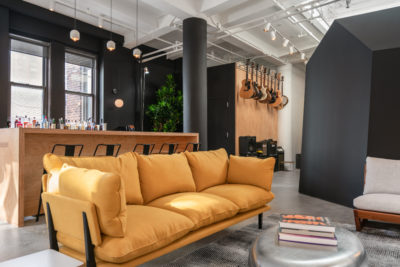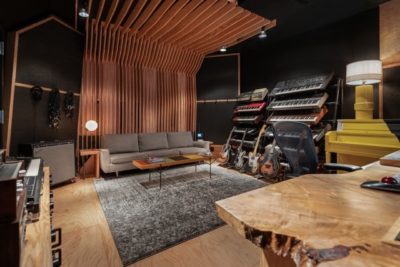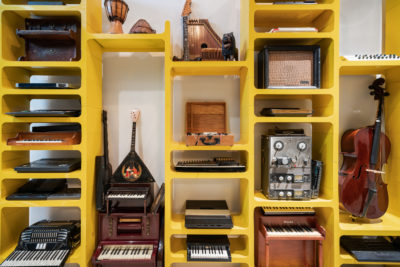Composer Cribs: Pull Music & Sound – A Diamond in the Garment District
It’s not easy to embrace change—especially when what you’ve been doing has worked well for a long time.
But as for most of the world, this past year has been different for Pull, the NYC-based full service music and production company. Besides pushing back on a global pandemic, Pull composer Mitch Davis and producer Scott Brittingham moved to a new studio.
Saying goodbye to their previous digs in SoHo couldn’t have been easy. After all, that’s where Pull built up a huge reel of music-to-picture work for advertising, film, TV, streaming platforms, and more. Beyond that, their expansive homebase had such an energized vibe that it attracted top artists to record there—we’re talking U2, Danger Mouse, Damon Albarn, Bobby Womack, Billy Squier, Mark Lanegan, Stephen Malkmus, and LA Guns.
As NYC denizens know, however, real estate realities can necessitate the move from even the sweetest of home sweet homes. For Pull, that meant a meticulous search for the ideal space to relocate, followed by a well-executed plan to provide Davis and his collaborators with an even better place to create.

Pull’s new home is an even better match for the way they make music and sound. (Photo Credit: Heidi Solander)
Studio Reassessment
After 12 years in the SoHo space, Davis had honed a unique control room workflow there. Visitors were greeted with a true audio man cave, containing Davis’ extensive collection of guitars, synths, analog outboard gear, eccentric instruments, and sonic knickknacks in sprawled-out fashion.
It was some wonderful clutter, within a workspace that Davis had learned to work to perfection over the course of 12 years. Ad clients there included top brands like Apple, Jeep, Chase, Lincoln, American Express, eBay, Northwell, Google, ESPN, Merceds-Benz, Nike, Cisco, Tiffany & Co., and many more. In addition to the aforementioned artistic collaborations, it was also where Davis wrote and recorded his personal projects like Orba Squara, a creative outlet that unintentionally spawned multiple synch licensing opportunities.
(Experience Pull’s full reel here.)With their move 20 or so blocks uptown to NYC’s garment district, Pull’s plan was to keep the best of what made Davis so productive, while moving on from the obsolete. “Over the years, technology changes, your tastes change, and music changes,” Davis says. “I knew that this gave me the opportunity to reassess how I was working and think of a new way that was more efficient.
“I wanted to bring things that were far away on the racks closer to me,” he continues. “I also wanted to take other things out of the room and get rid of them completely. The goal was more of a low profile, with everything kind of toward the ground—that felt right to me.”
A Holistic Approach
The 2,500-sq. ft. spot that Davis and Brittingham selected would be asked to fill a tall order to meet Pull’s needs. But don’t call it a studio! “It’s a flexible artistic space that can be used very creatively,” Davis clarifies. “We built it with a ‘the-“studio”-is-not-limited-to-just-the-control-room’ mindset.”
To pull it off, Pull worked with architect Christian Uhl on something one step beyond a room-within-a-room configuration. It would allow Davis to have an acoustically accurate composing/control room, while making the rest of the space ready as an alternate recording locale plus inspiring hangout with plenty of room for clients to relax (socially distanced, if need be).

A “house within a room.” Pull’s open space — note the exterior of the studio structure on the right. (Photo credit: Heidi Solander)
The solution is akin to a house within a room, a free-standing structure erected in the commercial space that’s equally appealing from the inside and outside. The interior sports a semi-diamond-shaped floor plan similar to Davis’ former SoHo suite, albeit with different proportions. “It’s like starting fresh with that same footprint,” Brittingham says.
Making what had previously been a non-audiocentric commercial space into a studio is a common test faced by composers in NYC and worldwide.
“One of the biggest challenges was figuring out how to make (the studio structure) free-standing,” Davis notes. “It’s a heavy room because of all the layers of sheetrock and soundproofing, and to be able to have a ceiling that can support itself. We had to build it with these huge steel beams that were welded together, which is unusual, because normally the ceiling is somehow suspended but here the roof has to be braced on something because it can’t support itself. It took some creative engineering for our architect to figure out how to get that part done.”
Creating simulations along the way proved invaluable to the design process. “There was a lot of re-engineering on the fly,” says Davis. “I made models of most things and put them in the room. But as you go you realize, ‘Maybe that doesn’t work as well in practice as it does on paper.’ Things don’t always work out the way you think it will.”
The Console, Reconfigured
Central to the refresh is Davis’ console. As often happens now, Davis’ updated workflow involved deleting a sizable mixing surface. Instead, a large piece of maple wood was custom cut to accommodate the outboard gear that Davis calls on most—now at his fingertips instead of several feet away.
“I wanted to have something that fit a hands-on approach,” Davis explains. “I record through a lot of analog gear, so I wanted to have all my outboard in front of me, the various compressors and EQs that I run through are here within arm’s reach, which I didn’t have in the past.”

Another view on the control room, the custom maple console is on the right. (Photo Credit: Heidi Solander)
One of the most eye-catching units is a circa-70’s Pioneer RT-707 ¼” tape machine, which is a go-to for Davis. “I’ll record to tape and then put it into Pro Tools so I can still do my normal editing, processing and manipulating of the audio, but I will get the tape sound,” he notes. “Sometimes I’ll record to tape first and then run it through Pro Tools, or I’ll record to Pro Tools and put that to tape and then back again. I like that because I can experiment with different ways of recording to tape. I’ll get the performance I want and then I can overdrive the tape to a clip, for example, and then I can go 15 IPS (inches per second) or seven-and-a-half. I can change all different settings and try different ways. It gets a really good sound, so I built the console around that.”
Another intriguing console component is its true centerpiece, a monitor that’s square as opposed to the ubiquitous rectangle. Designed for air traffic controllers, it was hunted down by Davis to achieve better visual balance for his DAW activities.
“Previously, I had been using a rectangular monitor in a vertical orientation,” says Davis. “That was working out well for me because I like to see more tracks on the screen and see further down the road. Then I realized I wanted to see even further down the road than I was, but it was getting a little too narrow. With this square monitor, I can see further and a little wider—you get more surface area than with the long monitor.”
In demand for his ability to authentically compose everything from Americana to metal to EDM and far beyond, Davis still has his music-making devices close at hand. This time, however, things are optimized to remain orderly, with only the most choice synths, guitars, and microphones making the cut to stay within his inner sanctum.
Everybody Get Together
Pull’s extended creative layout makes it even more useful in this time of social distancing, giving collaborators and clients plenty of space to spread out as needed. A well-stocked bar, sizable lounge area, and large windows make every corner inviting.
“Whenever you walk out of the control room, you’ve got this really nice, bright, home away from home,” Brittingham says. “It feels comfortable and uncrowded. We wanted to utilize the skylight. With the way the studio was constructed, it’s almost like a free-standing house underneath the skylight.”
All of which goes to show that although change can feel painful, moving forward puts you on an even more rewarding path. For the multifaceted Davis, shaping this updated space just may unlock the next level. “I settled in here with no problems at all—I just started working as easy as it’s ever been, even easier,” he reflects. “This feels like a much more creative environment.”
And although gatherings remain limited in number for the moment, once everyone emerges into the post-COVID world, Pull is optimized for the collective creative breakout that’s coming.
“Whether it’s for a film, TV, or a record, our mindset is the same: We’re making music,” Mitch Davis says. “This studio is even more than what I need. It’s what we need to do to work with other people.”
— David Weiss
Please note: When you buy products through links on this page, we may earn an affiliate commission.









[…] http://sonicscoop.com/2020/10/26/composer-cribs-pull-music-sound-a-diamond-in-the-garment-district/ Composer Cribs: Pull Music & Sound – A Diamond in the Garment District […]
[…] But as for most of the world, this past year has been different for Pull, the NYC-based full service music and production company. Besides pushing back on a global pandemic, Pull composer Read more… […]